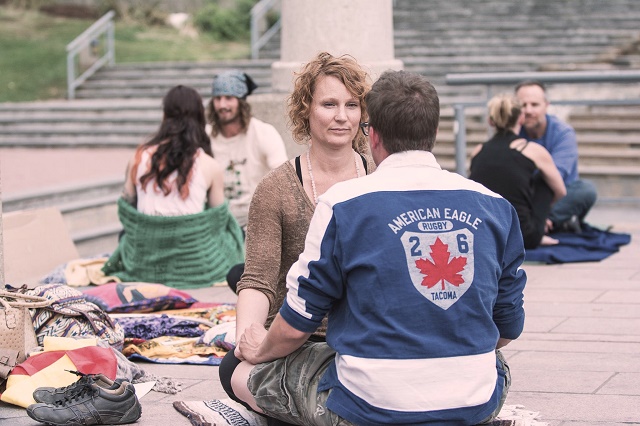
The collective heartache is real.
Ever present and ever healing, it is the pain we feel as a community when we witness social injustice. When we see terrorism, bigotry and atrocities committed against our brothers and sisters.
It is real. It is painful. And it is threaded through each of us.
I know I have a place in the collective heartache. We all do. I also know that I have a place in the healing process. We all do.
I experienced this firsthand several weeks ago, when some local activists and I organized the first “Human Connection Experiment” for our St. Louis community. In the past year, our city has been collectively wounded by the tragic shooting and death of a young black teen—a story that made national headlines and sparked controversy all over the world. Other communal trespasses followed thereafter, both in our city and in others. And a sickening swell of mistrust struck our community.
These senseless atrocities are devastating to the communal trust. They leave us wondering how to recover. How do we heal the collective heartache?
Enter the “Human Connection Experiment.” Our community’s attempt at revival.
The premise was simple. We planned a public gathering. We invited locals to come together and hold eye contact with each other for just one minute. No talking, no breaking gaze. For one minute.
One minute is longer than it sounds. I discovered it is an incredibly intimate experience.
We held our gathering in a public outdoor space, so passersby could easily engage with our group. Handmade signs reading “Where has the human connection gone? Share one minute of eye contact to find out.” were posted around the perimeter of the plaza, while blankets and pillows lay scattered about.
We had no idea if anyone would come. But we perched on our cushions and waited. Poised and erect in meditation pose, like little Buddha statues, holding hopes that some courageous souls would be just curious enough to wander into our cozy nest.
It started slow at first. Ten or so minutes of sitting and waiting with nothing but the hum of street traffic…
And then, a young 20-something woman approached the plaza. With a nervous smile, she timidly walked up to where I was seated. I returned a grin, big and bold and inviting. “Come sit with me,” I welcomed her. I explained the exercise. I could tell she was unsure, but she nodded sweetly.
“Ready? One, two, three,” I counted us in.
Locked into her gaze, I instantly noticed two marked features about her.
First, her stunning blue irises. Sweeping hues of cobalt and indigo. They brought me a sense of peace.
And second, the prominent scar on her face. A jagged pink fissure snaking from below her eye, along the bridge of her nose to her lower cheek.
I thought of how vulnerable she must feel. My eyes resting upon her cracked cheek and no words to break the knowingness of her insecurity. That too brought me a sense of peace—she trusted me.
Maybe 20 seconds in, there was a perceivable shift in her glassy blue orbs. I felt her relax into my gaze. From fear of being judged, to comfort of being connected. It was profoundly beautiful. I have no doubt she felt every second of our exchange.
We parted with a heartfelt hug. I watched her walk away, tension fully released from her gait, and marveled at how healing that shared minute was for us both.
And there were others. All with an unspoken story. All with an unspoken trust. A trust that there was no judgment here. No fear and no pain. Only acceptance. Only healing.
I shared a connection with 20 or so strangers that day. And I have since described the experiment to many of my friends. Most have confessed that the idea of sharing silent eye contact with complete strangers makes them feel uncomfortable.
It’s not surprising. Nowadays, it seems we are more prone to lock gaze with our smartphones and tablets rather than with each other. But I am hopeful that things are changing.
We are waking up. Especially in the tide of social tragedy and collective heartache.
When I reflect on why our human experiment was so healing, I realize that it starts and ends with connection. Because when we connect with one another, we are not simply sharing an experience or exchanging energy. We are practicing empathy.
It is within this sphere of empathy that we are most human. Most in-tune with our shared joy and pain. And it is only then that we can begin to heal the collective heartache.
Author: Cammie Noel
Editor: Nicole Cameron










Read 0 comments and reply